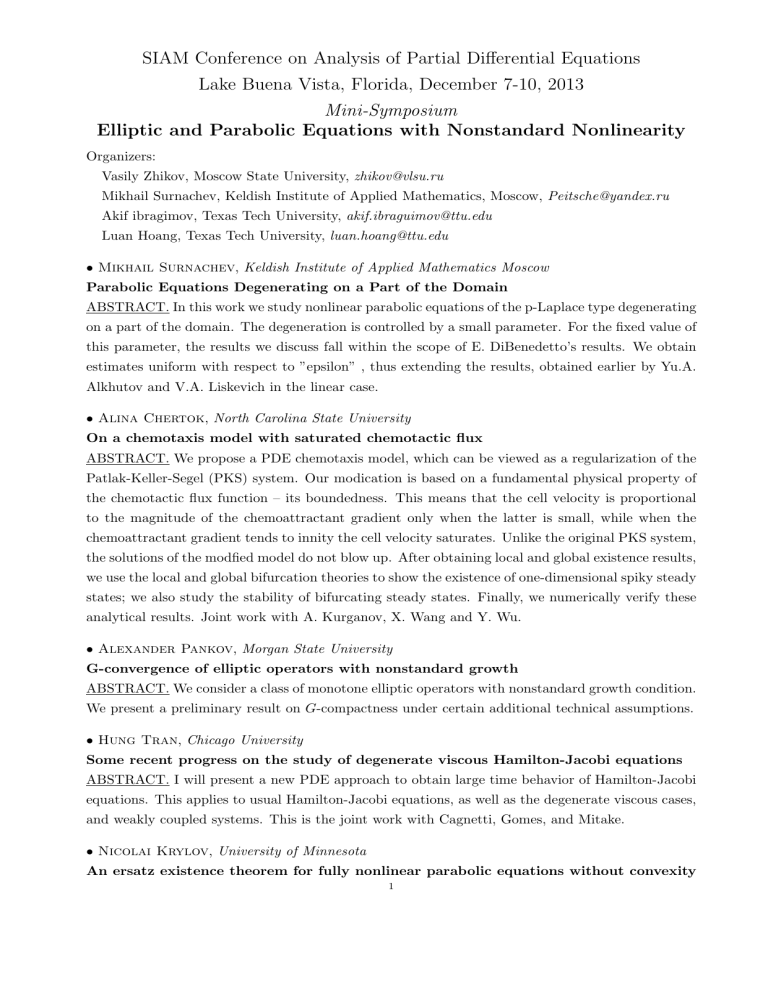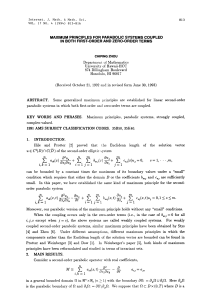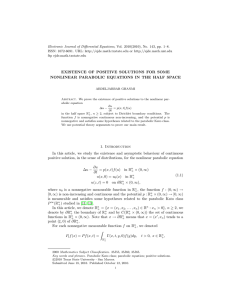SIAM Conference on Analysis of Partial Differential Equations

SIAM Conference on Analysis of Partial Differential Equations
Lake Buena Vista, Florida, December 7-10, 2013
Mini-Symposium
Elliptic and Parabolic Equations with Nonstandard Nonlinearity
Organizers:
Vasily Zhikov, Moscow State University, zhikov@vlsu.ru
Mikhail Surnachev, Keldish Institute of Applied Mathematics, Moscow, Peitsche@yandex.ru
Akif ibragimov, Texas Tech University, akif.ibraguimov@ttu.edu
Luan Hoang, Texas Tech University, luan.hoang@ttu.edu
•
Mikhail Surnachev
, Keldish Institute of Applied Mathematics Moscow
Parabolic Equations Degenerating on a Part of the Domain
ABSTRACT. In this work we study nonlinear parabolic equations of the p-Laplace type degenerating on a part of the domain. The degeneration is controlled by a small parameter. For the fixed value of this parameter, the results we discuss fall within the scope of E. DiBenedetto’s results. We obtain estimates uniform with respect to ”epsilon” , thus extending the results, obtained earlier by Yu.A.
Alkhutov and V.A. Liskevich in the linear case.
•
Alina Chertok
, North Carolina State University
On a chemotaxis model with saturated chemotactic flux
ABSTRACT. We propose a PDE chemotaxis model, which can be viewed as a regularization of the
Patlak-Keller-Segel (PKS) system. Our modication is based on a fundamental physical property of the chemotactic flux function – its boundedness. This means that the cell velocity is proportional to the magnitude of the chemoattractant gradient only when the latter is small, while when the chemoattractant gradient tends to innity the cell velocity saturates. Unlike the original PKS system, the solutions of the modfied model do not blow up. After obtaining local and global existence results, we use the local and global bifurcation theories to show the existence of one-dimensional spiky steady states; we also study the stability of bifurcating steady states. Finally, we numerically verify these analytical results. Joint work with A. Kurganov, X. Wang and Y. Wu.
•
Alexander Pankov
, Morgan State University
G-convergence of elliptic operators with nonstandard growth
ABSTRACT. We consider a class of monotone elliptic operators with nonstandard growth condition.
We present a preliminary result on G -compactness under certain additional technical assumptions.
•
Hung Tran
, Chicago University
Some recent progress on the study of degenerate viscous Hamilton-Jacobi equations
ABSTRACT. I will present a new PDE approach to obtain large time behavior of Hamilton-Jacobi equations. This applies to usual Hamilton-Jacobi equations, as well as the degenerate viscous cases, and weakly coupled systems. This is the joint work with Cagnetti, Gomes, and Mitake.
•
Nicolai Krylov
, University of Minnesota
An ersatz existence theorem for fully nonlinear parabolic equations without convexity
1
2 assumptions
ABSTRACT. We show that for any uniformly parabolic fully nonlinear second-order equation with bounded measurable “coefficients” and bounded “free” term in the whole space or in any cylindrical smooth domain with smooth boundary data one can find an approximating equation which has a continuous solution with the first and the second spatial derivatives under control: bounded in the case of the whole space and locally bounded in case of equations in cylinders. The approximating equation is constructed in such a way that it modifies the original one only for large values of the second spatial derivatives of the unknown function. This is different from a previous work of Hongjie
Dong and the author where the modification was done for large values of the unknown function and its spatial derivatives.
•
Ana Zemlyanova
, Texas A&M University
A new curvature-dependent surface tension model in fracture mechanics
ABSTRACT. A new approach to modeling of a brittle fracture based on an extension of a continuum mechanics to the nanoscale will be considered. The classical Neumann boundary condition on the fracture surface is augmented with a curvature-dependent surface tension. The model is studied on an example of a plain-strain mixed mode fracture. Using complex variable methods, the mechanical problem is reduced to a system of coupled Cauchy singular integro-differential equations.
The regularization and the numerical solution of this system is considered. It is shown that incorporation of a curvature-dependent surface tension into fracture modeling eliminates the integrable crack-tip stress and strain singularities of order 1/2 present in the classical linear fracture mechanics solutions.
Directions for the future research in this area will be presented.
•
Thinh Kieu
, Texas Tech University
Two-phase generalized Forchheimer flows
ABSTRACT. We study two-phase generalized Forchheimer flows of incompressible fluids in porous media.
Symmetric steady states are found.
We prove their linear asymptotic stability in case bounded domain, and their linear stability in case of unbounded domain. The lemmas of growth of
Landis type are used with explicit barrier functions constructed based on the particular structure of the steady states.
•
Hoai-Minh Nguyen
, University of Minnesota
Complementary media in metamaterials
ABSTRACT. In this talk, I will discuss the frame work of complementary media in metamaterials.
Resonant and localized resonant phenomena will be discussed. Applications in cloaking will be given.
•
Akif Ibragimov
, Texas Tech University
Landis-type Lemma of Growth in the Layered Cylinders for Solution of the Degenerate
Parabolic Equation and Applications
ABSTRACT. We consider a parabolic equation of second order in unbounded domain with Dirichlet type boundary conditions. Corresponding operator can degenerate at infinity with respect to x and t . The lemma of growth will be proved for a class of solutions in layered cylinder. Using this lemma
3 we prove a parabolic analog of P hragm ´ Lindel of type principle in x and t directions. This is joint work with L.Hoang and T.Kieu
•
Lidia Bloshanskaya
, Texas Tech University
Upscaling of Forchheimer Flows
ABSTRACT. In this work we propose upscaling method for nonlinear Forchheimer flow in highly heterogeneous porous media. The generalized Forchheimer law is considered for incompressible and slightly-compressible single-phase flows. We use recently developed analytical results by E.Aulisa,
L.Bloshaskaya, L.Hoang, and A.Ibragimov [J. Math. Phys. 50, 103102 (2009)] and formulate the resulting system in terms of a degenerate nonlinear flow equation for the pressure with the nonlinearity depending on the pressure gradient. The coarse scale parameters for the steady state problem are determined so that the volumetric average of velocity of the flow in the domain on fine scale and on coarse scale are close. A flow-based coarsening approach is used, where the equivalent permeability tensor is first evaluated following streamline methods for linear cases, and modified in order to take into account the nonlinear effects. The developed upscaling algorithm for nonlinear steady state problems is effectively used for variety of heterogeneities in the domain of computation.
Direct numerical computations for average velocity and productivity index justify the usage of the coarse scale parameters obtained for the special steady state case in the fully transient problem. For nonlinear case analytical upscaling formulas in stratified domain are obtained. Numerical results were compared to these analytical formulas and proved to be highly accurate. This is the joint work with E.Aulisa, A.Ibragimov and Y.Efendiev.
•
Vasily V. Zhikov
, Vladimir State University, Vladimir, Russia.
On passage to the limit in nonlinear Elliptic and Parabolic Equations
ABSTRACT. Passing to the limit in nonlinear terms one encounters the fundamental problem of
”weak convergence of fluxes to a flux”. The term ”flux” refers to the vector A ( x, ∇ u
ε
) which stands in the elliptic equation under the divergence sign. Usually one has the weak convergence u
ε
* u in some Sobolev space and the weak convergence of the fluxes A ( x, ∇ u
ε
) * z in some Lebesgue space.
This leads to the problem of the equality z = A ( x, ∇ u ). Let us state one result in this direction.
Assume that
(1) u
ε
* u in W
1 ,α
(Ω), α > 1;
(2) the symbol A is monotone:
( A ( x, ξ ) − A ( x, η )) · ( ξ − η ) ≥ 0;
(3) div A ( x, ∇ u
ε
) = 0 in the sense of distributions,
A
ε
≡ A ( x, ∇ u
ε
) * z in L
β
0
(Ω) , β
0
=
β
β − 1
;
(4) 1 < α ≤ β < α
∗
,
α
∗
=
( α ( N − 1)
N − 1 − α
+ ∞ for for
α < N
α ≥ N
−
−
1
1;
,
(5) the family of ”energy densities” A
ε
· ∇ u
ε is bounded in L
1
(Ω);
(6) u
ε
∈ W
1 ,β
(Ω) (additional regularity of prelimit functions).
4
Then z = A ( x, ∇ u ). (Note that in the classical case when α = β the last three conditions hold automatically.)
In this talk we will discuss the following applications:
• monotone elliptic operators with nonstandard growth conditions;
• thermistor problem;
• generalized Navier-Stokes equations.






